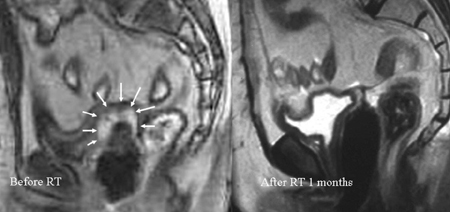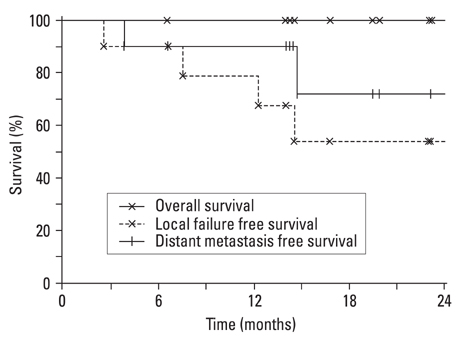Yonsei Med J.
2010 Jan;51(1):93-99. 10.3349/ymj.2010.51.1.93.
High Dose Three-Dimensional Conformal Boost Using the Real-Time Tumor Tracking Radiotherapy System in Cervical Cancer Patients Unable to Receive Intracavitary Brachytherapy
- Affiliations
-
- 1Department of Radiology, Hokkaido University Graduate School of Medicine, Sapporo, Japan. shirato@med.hokudai.ac.jp
- 2Department of Radiation Oncology, Sungkyunkwan University School of Medicine, Samsung Medical Center, Seoul, Korea.
- 3Department of Gynecology, Hokkaido University Graduate School of Medicine, Sapporo, Japan.
- KMID: 1779612
- DOI: http://doi.org/10.3349/ymj.2010.51.1.93
Abstract
- PURPOSE
The purpose of this study is to evaluate the clinical results of treatment with a high dose of 3-dimensional conformal boost (3DCB) using a real-time tracking radiation therapy (RTRT) system in cervical cancer patients. MATERIALS AND METHODS: Between January 2001 and December 2004, 10 patients with cervical cancer were treated with a high dose 3DCB using RTRT system. Nine patients received whole pelvis radiation therapy (RT) with a median dose of 50 Gy (range, 40-50 Gy) before the 3DCB. The median dose of the 3DCB was 30 Gy (range, 25-30 Gy). Eight patients received the 3DCB twice a week with a daily fraction of 5 Gy. The determined endpoints were tumor response, overall survival, local failure free survival, and distant metastasis free survival. The duration of survival was calculated from the time of the start of radiotherapy. RESULTS: All patients were alive at the time of analysis and the median follow-up was 17.6 months (range, 4.9-27.3 months). Complete response was achieved in nine patients and one patient had a partial response. The 1- and 2-year local failure free survival was 78.8% and 54%, respectively. The 1- and 2-year distant metastasis free survival was 90% and 72%, respectively. Late toxicity of a grade 2 rectal hemorrhage was seen in one patient. A subcutaneous abscess was encountered in one patient. CONCLUSION: The use of the high dose 3DCB in the treatment of cervical cancer is safe and feasible where intracavitary brachytherapy (ICBT) is unable to be performed. The escalation of the 3DCB dose is currently under evaluation.
MeSH Terms
Figure
Cited by 1 articles
-
Correlations of Dynamic Contrast-Enhanced Magnetic Resonance Imaging with Morphologic, Angiogenic, and Molecular Prognostic Factors in Rectal Cancer
Hye-Suk Hong, Se Hoon Kim, Hae-Jeong Park, Mi-Suk Park, Ki Whang Kim, Won Ho Kim, Nam Kyu Kim, Jae Mun Lee, Hyeon Je Cho
Yonsei Med J. 2013;54(1):123-130. doi: 10.3349/ymj.2013.54.1.123.
Reference
-
1. Park HC, Suh CO, Kim GE. Fractionated high-dose-rate brachytherapy in the management of uterine cervical cancer. Yonsei Med J. 2002. 43:737–748.
Article2. Hughes-Davies L, Silver B, Kapp DS. Parametrial interstitial brachytherapy for advanced or recurrent pelvic malignancy: the Harvard/Stanford experience. Gynecol Oncol. 1995. 58:24–27.
Article3. Matsuura K, Tanimoto H, Fujita K, Hashimoto Y, Murakami Y, Kenjo M, et al. Early clinical outcomes of 3D-conformal radiotherapy using accelerated hyperfractionation without intracavitary brachytherapy for cervical cancer. Gynecol Oncol. 2007. 104:11–14.
Article4. Kato S, Ohno T, Tsujii H, Nakano T, Mizoe JE, Kamada T, et al. Dose escalation study of carbon ion radiotherapy for locally advanced carcinoma of the uterine cervix. Int J Radiat Oncol Biol Phys. 2006. 65:388–397.5. Mollá M, Escude L, Nouet P, Popowski Y, Hidalgo A, Rouzaud M, et al. Fractionated stereotactic radiotherapy boost for gynecologic tumors: an alternative to brachytherapy? Int J Radiat Oncol Biol Phys. 2005. 62:118–124.6. Kagei K, Tokuuye K, Okumura T, Ohara K, Shioyama Y, Sugahara S, et al. Long-term results of proton beam therapy for carcinoma of the uterine cervix. Int J Radiat Oncol Biol Phys. 2003. 55:1265–1271.
Article7. Ulmer HU, Frischbier HJ. Treatment of advanced cancers of the cervix uteri with external irradiation alone. Int J Radiat Oncol Biol Phys. 1983. 9:809–812.
Article8. Castro JR, Issa P, Fletcher GH. Carcinoma of the cervix treated by external irradiation alone. Radiology. 1970. 95:163–166.
Article9. Shirato H, Shimizu S, Kunieda T, Kitamura K, van Herk M, Kagei K, et al. Physical aspects of a real-time tumor-tracking system for gated radiotherapy. Int J Radiat Oncol Biol Phys. 2000. 48:1187–1195.
Article10. Kitamura K, Shirato H, Shinohara N, Harabayashi T, Onimaru R, Fujita K, et al. Reduction in acute morbidity using hypofractionated intensity-modulated radiation therapy assisted with a fluoroscopic real-time tumor-tracking system for prostate cancer: preliminary results of a phase I/II study. Cancer J. 2003. 9:268–276.
Article11. Shimizu S, Shirato H, Kitamura K, Shinohara N, Harabayashi T, Tsukamoto T, et al. Use of an implanted marker and real-time tracking of the marker for the positioning of prostate and bladder cancers. Int J Radiat Oncol Biol Phys. 2000. 48:1591–1597.12. Yamamoto R, Yonesaka A, Nishioka S, Watari H, Hashimoto T, Uchida D, et al. High dose three-dimensional conformal boost (3DCB) using an orthogonal diagnostic X-ray set-up for patients with gynecological malignancy: a new application of real-time tumor-tracking system. Radiother Oncol. 2004. 73:219–222.
Article13. Kagei K, Shirato H, Nishioka T, Kitahara T, Suzuki K, Tomita M, et al. High-dose-rate intracavitary irradiation using linear source arrangement for stage II and III squamous cell carcinoma of the uterine cervix. Radiother Oncol. 1998. 47:207–213.14. Benedet JL, Bender H, Jones H 3rd, Ngan HY, Pecorelli S. FIGO staging classifications and clinical practice guidelines in the management of gynecologic cancers. FIGO Committee on Gynecologic Oncology. Int J Gynaecol Obstet. 2000. 70:209–262.15. Cox JD, Stetz J, Pajak TF. Toxicity criteria of the Radiation Therapy Oncology Group (RTOG) and the European Organization for Research and Treatment of Cancer (EORTC). Int J Radiat Oncol Biol Phys. 1995. 31:1341–1346.16. Kaplan EL, Meier P. Nonparametric estimation from incomplete observations. J Am Stat Assoc. 1958. 63:457–481.
Article17. Aydogan B, Mundt AJ, Smith BD, Mell LK, Wang S, Sutton H, et al. A dosimetric analysis of intensity-modulated radiation therapy (IMRT) as an alternative to adjuvant high-dose-rate (HDR) brachytherapy in early endometrial cancer patients. Int J Radiat Oncol Biol Phys. 2006. 65:266–273.
Article18. Wahab SH, Malyapa RS, Mutic S, Grigsby PW, Deasy JO, Miller TR, et al. A treatment planning study comparing HDR and AGIMRT for cervical cancer. Med Phys. 2004. 31:734–743.
Article19. Schefter TE, Kavanagh BD, Wu Q, Tong S, Newman F, McCourt S, et al. Technical considerations in the application of intensity-modulated radiotherapy as a concomitant integrated boost for locally-advanced cervix cancer. Med Dosim. 2002. 27:177–184.
Article20. Low DA, Grigsby PW, Dempsey JF, Mutic S, Williamson JF, Markman J, et al. Applicator-guided intensity-modulated radiation therapy. Int J Radiat Oncol Biol Phys. 2002. 52:1400–1406.
Article21. Chan P, Yeo I, Perkins G, Fyles A, Milosevic M. Dosimetric comparison of intensity-modulated, conformal, and four-field pelvic radiotherapy boost plans for gynecologic cancer: a retrospective planning study. Radiat Oncol. 2006. 1:13.
Article22. Nag S, Erickson B, Thomadsen B, Orton C, Demanes JD, Petereit D. The American Brachytherapy Society recommendations for high-dose-rate brachytherapy for carcinoma of the cervix. Int J Radiat Oncol Biol Phys. 2000. 48:201–211.
Article23. Pötter R, Haie-Meder C, Van Limbergen E, Barillot I, De Brabandere M, Dimopoulos J, et al. Recommendations from gynaecological (GYN) GEC ESTRO working group (II): concepts and terms in 3D image-based treatment planning in cervix cancer brachytherapy-3D dose volume parameters and aspects of 3D image-based anatomy, radiation physics, radiobiology. Radiother Oncol. 2006. 78:67–77.
Article24. Haie-Meder C, Pötter R, Van Limbergen E, Briot E, De Brabandere M, Dimopoulos J, et al. Recommendations from Gynaecological (GYN) GEC-ESTRO Working Group (I): concepts and terms in 3D image based 3D treatment planning in cervix cancer brachytherapy with emphasis on MRI assessment of GTV and CTV. Radiother Oncol. 2005. 74:235–245.
Article25. Chao KS, Williamson JF, Grigsby PW, Perez CA. Uterosacral space involvement in locally advanced carcinoma of the uterine cervix. Int J Radiat Oncol Biol Phys. 1998. 40:397–403.
Article26. Tomé WA, Fowler JF. On cold spots in tumor subvolumes. Med Phys. 2002. 29:1590–1598.
Article27. Tomé WA, Fowler JF. Selective boosting of tumor subvolumes. Int J Radiat Oncol Biol Phys. 2000. 48:593–599.
Article28. Lee SW, Back GM, Yi BY, Choi EK, Ahn SD, Shin SS, et al. Preliminary results of a phase I/II study of simultaneous modulated accelerated radiotherapy for nondisseminated nasopharyngeal carcinoma. Int J Radiat Oncol Biol Phys. 2006. 65:152–160.
Article29. Shirato H, Oita M, Fujita K, Watanabe Y, Miyasaka K. Feasibility of synchronization of real-time tumor-tracking radiotherapy and intensity-modulated radiotherapy from viewpoint of excessive dose from fluoroscopy. Int J Radiat Oncol Biol Phys. 2004. 60:335–341.
Article
- Full Text Links
- Actions
-
Cited
- CITED
-
- Close
- Share
- Similar articles
-
- Radiation therapy of cervical cancer: Current status in Korea and recent developments
- Accuracy of Dose Estimation in High Dose Rate Intracavitary Radiotherapy of Carcinoma of the Uterine Cervix
- Treatment Planning Software for High Dose Rate Remote Afterloading Brachytherapy of Uterine Cervical Cancer
- Radiation sigmoiditis mimicking sigmoid colon cancer after radiation therapy for cervical cancer: the implications of three-dimensional image-based brachytherapy planning
- Fractionated High-Dose-Rate Brachytherapy in the Management of Uterine Cervical Cancer




